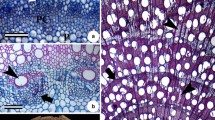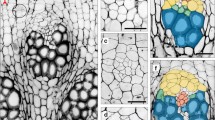Abstract
Argyreia is one of the dominant genera of the family Convolvulaceae and is mainly distributed in the tropical and sub-tropical regions of Southeast Asia, the Indian subcontinent and China. In the present study, Argyreia elliptica (Roth) Choisy (Convolvulaceae) is investigated histologically, which showed the development of various kinds of variant secondary growth (multiple cambia, inter-and intraxylary phloem, internal/medullary cambium and inversely oriented successive cambia). The first ring of successive cambium in the main stem and branches initiated from the cells located on the inner margin of pericyclic fibres while subsequent cambia initiated from parenchyma cells external to the phloem formed by earlier cambium. During the initiation, either a few cells become meristematic and directly differentiated into lignified xylem element followed by the cambium became noticeable or the cambium initiates first and formed xylem first followed by phloem. Primary intraxylary phloem initiates concomitant to the protoxylem and protophloem. Additional secondary intraxylary phloem originated from the pith cells and the activity of the internal cambium. In thick stems, interxylary phloem differentiated within the parenchyma islands located within the secondary xylem. A unique and hitherto unreported feature observed is the development of xylem cylinders (without phloem) from the parenchyma cells located external to the phloem of the earlier formed successive cambium. These strands were exclusively composed of fibres and fibriform vessels while wide vessels were observed occasionally. The development of various types of cambial variants is elucidated in detail and compared with the available literature on the family Convolvulaceae.







Similar content being viewed by others
References
Angyalossy A, Pace MR, Lima AC (2015) Liana anatomy: a broad perspective on structural evolution of vascular system. In: Bongers F, Burnham RJ, Putz FE (eds) Schnitzer SA. Ecology of Lianas John Wiley & Sons, Oxford
Berlyn GP, Miksche JP (1976) Botanical microtechnique and cytochemistry. The Iowa State University Press, Ames, IA
Cabanillas PA, Pace MR, Angyalossy V (2017) Structure and ontogeny of fissured stems of Callaeum (Malpighiaceae). IAWA J 38:49–66. https://doi.org/10.1163/22941932-20170156
Carlquist S (1988) Comparative wood anatomy: systematic ecological and evolutionary aspect of dicotyledonous wood. Springer-Verlag, New York, NY
Carlquist S (2001) Comparative wood anatomy: systematic ecological and evolutionary aspect of dicotyledonous wood. Springer-Verlag, New York, NY
Carlquist S (2013) Interxylary phloem: Diversity and functions. Brittonia 65:477–495. https://doi.org/10.1007/s12228-012-9298-1
Carlquist S, Hanson MA (1991) Wood and stem anatomy of Convolvulaceae: a survey. Aliso 13:51–94. https://doi.org/10.5642/aliso.19911301.03
Carlquist S (2007) Successive cambia revisited: ontogeny, histology, diversity and functional significance. J Torrey Bot Soc 134:301–32. https://www.jstor.org/stable/20063919
Dobbins DR, Fisher JB (1986) Wound responses in girdled stems of lianas. Bot Gaz 147: 278–289. https://www.jstor.org/stable/2474397
Fisher JB, Ewers FW (1989) Wound healing in stems of lianas after twisting and girdling injuries. Bot. Gaz. 150: 251–265. https://www.jstor.org/stable/2995197
Fisher JB, Ewers FW (1992) Xylem pathways in liana stems with anomalous secondary growth. Bot J Linn Soc 180:181–202. https://doi.org/10.1111/j.1095-8339.1992.tb01640.x
Fukuda Y (1967) Anatomical study of the internal phloem in the stems of dicotyledons, with special reference to its histogenesis. J Fac Sci, Univ Tokyo III 9:313–375
Gentry AH, Dodson C (1987) Contribution of nontrees to species richness of a tropical rain forest. Biotropica 19:149–156. https://doi.org/10.2307/2388737
Hallier HJG (1893) Versuch einer naturlichen gliederung der Convolvulaceen auf morphologischer und anatomischer grundlage. Bot. Jahrb. Für Syst. Pflanzen Und Pflanzengeographie 16:453–591
Handa T (1937) Abnormal vascular bundles in the stem of Campsis grandiflora K. Schum Japanese J Bot 8:47–57
Hérail J (1885) Recherches sur l’anatomie compare de la tige des dicotyledones. Ann Sci Nat, Bot VII 2:203–314
Isnard S, Silk WK (2009) Moving with climbing plants from Charles Darwin’s time into the 21st century. Amer J Bot 96:1205–1221. https://doi.org/10.3732/ajb.0900045
Johansen DA (1940) Plant microtechnique. McGraw Hill, New York, NY
Kapadane KK, Shelke RA, Gondaliya AD, Rajput KS (2019) Formation of medullary phloem in Argyreia nervosa (Burm.f.) Bojer. Plant Sci Today 6:151–159. https://doi.org/10.14719/pst.2019.6.2.498
Kennedy PB, Crafts AS (1931) The anatomy of Convolvulus arvensis, wild morning glory or field bindweed. Hilgardia 5:591–622. https://doi.org/10.3733/hilg.v05n18p591
Kim SH, Mizuno K, Fujimura T (2002) Isolation of MADS-box genes from sweet potato (Ipomoea batatas (L.) Lam. expressed specifically in vegetative tissue. Plant Cell Physiol 43:314–322. https://doi.org/10.1093/pcp/pcf043
Lekhak MM, Gondaliya AD, Yadav SR, Rajput KS (2018) Stem anatomy at various developmental stages of secondary growth in Turbina corymbosa (Convolvulaceae). Plant Ecol Evol 152:219–230. https://doi.org/10.5091/plecevo.2018.1389
Lowell C, Lucansky TW (1986) Vegetative anatomy and morphology of Ipomoea hederifolia (Convolvulaceae). Bull Torrey Bot Club 113:382–397. https://doi.org/10.2307/2996431
Lowell C, Lucansky TW (1990) Vegetative anatomy and morphology of Ipomoea quamoclit (Convolvulaceae). Bull Torrey Bot Club 117:232–246. https://doi.org/10.2307/2996692
McDonald JA (1992) Evolutionary implications of typical and anomalous secondary growth in arborescent Ipomoea (Convolvulaceae). Bull Torrey Bot Club 119:262–267. https://doi.org/10.2307/2996757
McLean JD, Richardson PE (1973) Vascular ray cells in woody stems. Phytomorphology 23:59–64
Metcalfe CR, Chalk L (1950) Anatomy of the dicotyledons. Clarendon Press, Oxford
Metcalfe CR, Chalk L (1983) Anatomy of the Dicotyledons, vol 2. The Clarendon Press, Oxford
Nazma BS, Vijendra Rao R (1981) Occurrence of perforated ray cells in the wood of Dryptes roxburghii (Wall.) Hurusava. IAWA Bulletin 2:201–202
Obaton M (1960) Les lianes ligneuses a structure anormale des forets dense d’afrique occidentale. Ann Sci Nat Bot Ser 12(1):1–220
Pant DD, Bhatnagar S (1975) Morphological studies in Argyreia Lour. (Convolvulaceae). Bot J Linn Soc 70:45–69. https://doi.org/10.1111/j.1095-8339.1975.tb00678.x
Patil VS, Rao KS, Rajput KS (2009) Development of intraxylary phloem and internal cambium in Ipomoea hederifolia (Convolvulaceae). J Torrey Bot Soc 136:423–432. https://doi.org/10.3159/09-RA-033.1
Patil VS, Koyani RD, Sanghvi GV, Rajput KS (2014) Structure and development of internal phloem in Solanum pseudocapsicum (Solanaceae). IAWA J 35:1–11. https://doi.org/10.1163/22941932-00000042
Pfeiffer H (1926) Das abnorme. Dickenwachstum. In: Linsbauer K. (Ed.), Handbuch der Pflanzenanatomie, Gebrüder Bornträger Verlag, Berlin
Rajput KS, Gondaliya AD (2017) Internal cambium and intraxylary phloem development in Ipomoea turbinata Lag. (Convolvulaceae). Flora 226:47–54. https://doi.org/10.1016/j.flora.2016.11.002
Rajput KS, Rao KS, Patil VS (2013) Wood Anatomy and the development of interxylary phloem of Ipomoea hederifolia Linn. (Convolvulaceae). J Plant Growth Regul 32:654–662. https://doi.org/10.1007/s00344-013-9334-8
Rajput KS, Patil VS, Rao KS (2014) Stem anatomy of dwarf subshrub Cressa cretica L. (Convolvulaceae). Flora 209:408–413. https://doi.org/10.1016/j.flora.2014.06.006
Rajput KS, Lekhak MM, Kapadane KK, Yadav SR (2017) Formation of trilobed stem and successive cambia in the stems of Argyreia hookeri C. B. Clarke (Convolvulaceae). Flora 233:140–149. https://doi.org/10.1016/j.flora.2017.06.005
Rajput KS, Gondaliya AD, Baijnath H (2021) Development of cambial variant and parenchyma proliferation in Hewittia malabarica (Convolvulaceae) from India and South Africa. IAWA J 42(1):50–63. https://doi.org/10.1163/22941932-bja10046
Rowe NP, Speck T (2005) Plant growth forms: an ecological and evolutionary perspective. New Phytol 166:61–72. https://doi.org/10.1111/j.1469-8137.2004.01309.x
Rowe NP, Isnard S, Speck T (2004) Diversity of mechanical architecture in climbing plants: an evolutionary perspective. J Plant Growth Regul 23:108–128. https://doi.org/10.1007/s00344-004-0044-0
Schenck H (1893) Beiträge zur Biologie und Anatomie der Lianen, im Besonderen der in Brasilien einheimischen Arten. II. Beiträge zur Biologie der Lianen.
Schnitzer SA, Bongers F (2011) Increasing liana abundance and biomass in tropical forests: emerging patterns and putative mechanisms. Ecol Lett 14:397–406. https://doi.org/10.1111/j.1461-0248.2011.01590.x
Schnitzer SA, Kuzee ME, Bongers F (2005) Disentangling above-and below-ground competition between lianas and trees in a tropical forest. J Ecology 93:1115–1125. https://doi.org/10.1111/j.1365-2745.2005.01056.x
Scott D H, Brebner G (1891) On the internal phloem in the root and stem of dicotyledons. Ann Bot XIX: 259–300. https://www.jstor.org/stable/43233781
Serdar B, Gerçek Z, Merev N (2004) Perforated ray cells in Salix rizeensis (Salicaceae). IAWA J 25:119–120
Solereder H (1908) Systematic Anatomy of the Dicotyledons (Vol I). Translated by Boodle LA, Fritsch FE and revised by Scott DH. Oxford: Clarendon Press, pp 562–575.
Sonsin JO, Machado SR, Marcati CR (2008) Perforated ray cells in the wood of roots and branches of Cerrado species from Brazil. IAWA J 29:291–299. https://doi.org/10.1163/22941932-90000187
Spicer R, Groover A (2010) Evolution of development of vascular cambia and secondary growth. New Phytol 186:577–592. https://doi.org/10.1111/j.1469-8137.2010.03236.x
Srebotnik E, Messner K (1994) A simple method that uses differential staining and light microscopy to assess the selectivity of wood delignification by white-rot fungi. Appl Environ Microbiol 60:1383–1386
Tamaio N, Braga JMA (2021) Rajput KS (2021) Development of successive cambia and structure of secondary xylem in the stems and roots of Distimake tuberosus (Convolvulaceae). Flora 279:151814. https://doi.org/10.1016/j.flora.2021.151814
Terrazas T, Aguilar-Rodríguez S, Ojanguren CT (2011) Development of successive cambia, cambial activity, and their relationship to physiological traits in Ipomoea arborescens (Convolvulaceae) seedlings. Amer J Bot 98:765–774. https://doi.org/10.3732/ajb.1000182
Yang S-Z, Chen P-H, Chen C-F (2020) Cambial variants combine successive cambia and intraxylary phloem in Convolvulaceae in Taiwan. Amer J Plant Sci 11:437–453. https://doi.org/10.4236/ajps.2020.113032
Acknowledgements
Present work is dedicated to Prof. Sherwin Carlquist (July 1930 – December 2021) for his immense contribution in the field of Island Biology, Plant and Ecological/systematic wood anatomy, particularly in the field of increase in woodiness. The authors are thankful to Mr. Amit D. Gondaliya for his help during histological preparations. The authors are also thankful to the Editor and both the anonymous reviewers for their valuable suggestions on the earlier version of the manuscript.
Author information
Authors and Affiliations
Contributions
Conceptualization and design, KKK and KSR; Sample collection and histological preparation, KKK, PRL and VBS; Analysis and interpretation, KSR and KKK; Investigation, KKK, PRL, VSB and KSR; Writing: original draft, KSR, and VBS; Writing: review and editing, KSR and VBS.
Corresponding author
Ethics declarations
Conflict of interest
The authors have no competing interests to declare that are relevant to the content of this article.
Additional information
Handling Editor: Stephen Werbrouck.
Publisher's Note
Springer Nature remains neutral with regard to jurisdictional claims in published maps and institutional affiliations.
Rights and permissions
About this article
Cite this article
Kapadane, K.K., Lawand, P.R., Shimpale, V.B. et al. Development of Cambial Variant and Structure of the Secondary Xylem in Argyreia elliptica (Roth) Choisy (Convolvulaceae). J Plant Growth Regul 42, 2506–2518 (2023). https://doi.org/10.1007/s00344-022-10722-1
Received:
Accepted:
Published:
Issue Date:
DOI: https://doi.org/10.1007/s00344-022-10722-1




